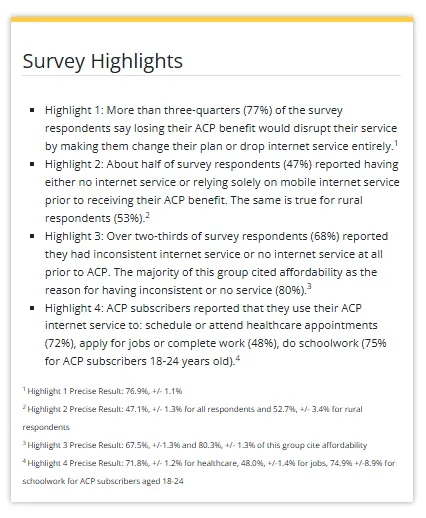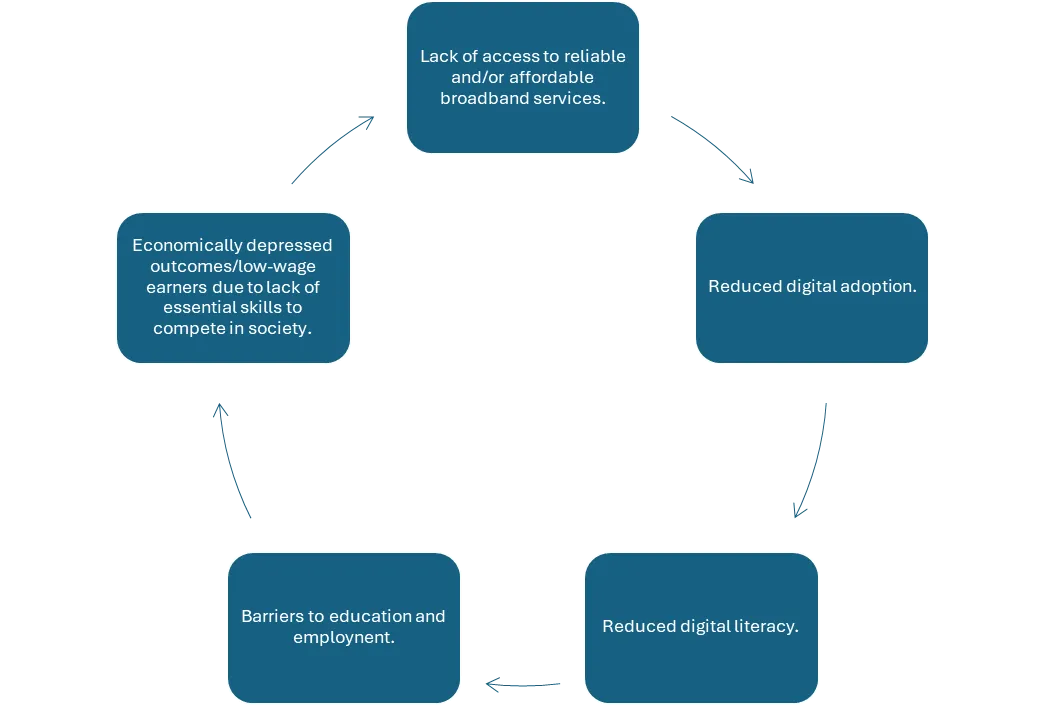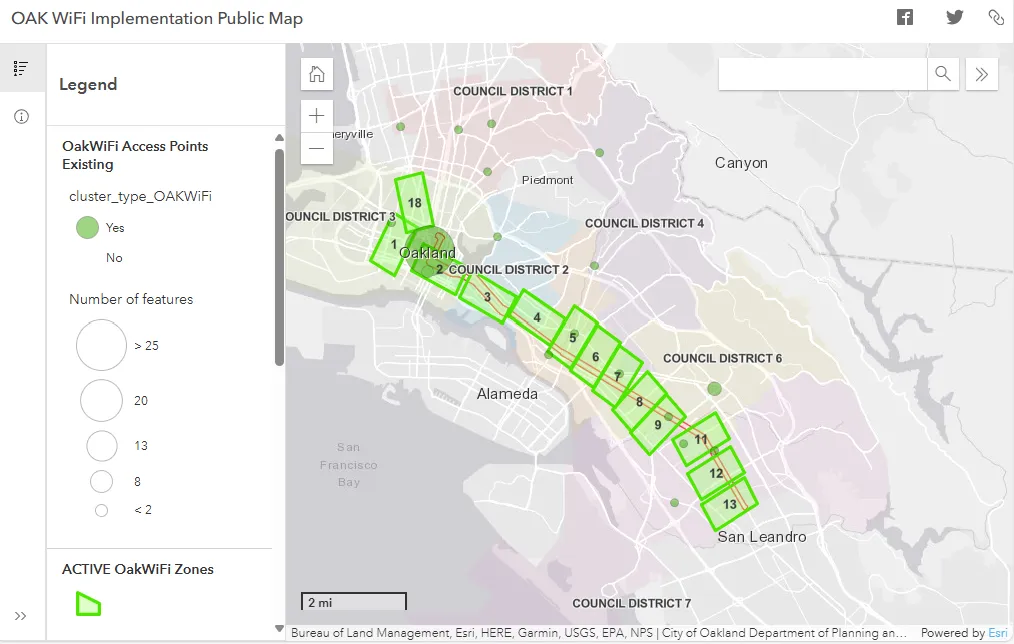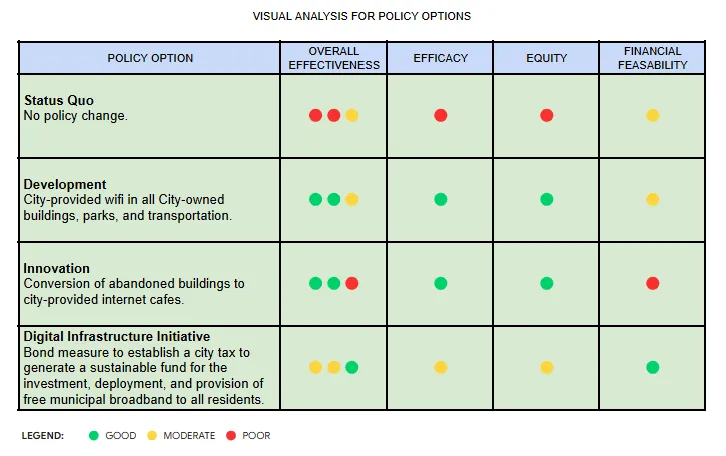Connecting Oakland
Policy Recommendations to Expand Broadband Internet Deployment Across Oakland, Eliminating Barriers to Digital Literacy and Closing the Digital Divide
by Jasmine Bellow

Executive Summary
The City of Oakland is not adequately meeting the internet service needs of its residents. Residual effects of historical redlining, digital redlining, inequitable investment in digital infrastructure in low-income communities, and the lack of affordable internet service providers has created deep disparities in access to reliable, high speed internet in the homes of many underserved communities in Oakland. Local efforts by community-based organizations like #OaklandUndivided and the Town Link Program1, along with state funding and federal efforts like the Affordable Connectivity Program, are working in collaboration to close the digital divide, yet low-income households are still suffering from the lack of or unreliable access to high speed internet. This report will investigate opportunities to support the City of Oakland in equitably closing this gap.
Background
Oakland is one of many cities across the nation still facing the effects of redlining from nearly a century ago. A 2020 report released by the Greenlining Institute illuminated the connection between neighborhoods lacking broadband access and those that had been redlined going back to the 1930s where both the government and private sector deliberately denied loans and investment to communities of color creating lasting economic disparity. Even though the practice has been outlawed since 19682, investigations reveal that it still occurs today.3 Its latest iteration comes in the form of selective investment in digital infrastructure where traditionally, large internet service providers have invested in “wealthier regions, where they can sell large internet packages and have a reliable return on investment” while neglecting poorer ones.4 This has been coined “digital redlining”5 and data from 2018 supports this notion observing that “24.2 percent of Oakland households (40,121) did not have home fixed broadband access of at least 25/3 Mbps, with 36 percent (14,619) of this group only connecting through cellular data plans and the remainder simply not connected at all” along the same redlined regions in the west, central, and east areas of the city.6
Problem
Despite local and national efforts, too many households in historically redlined Oakland neighborhoods still do not have reliable, high speed home internet.
Quantification
“An estimated 94,000 residents do not have internet service in Oakland. That is more than 20% of the city's population of about 434,000.”7 Moreover, in “pockets of Alameda County, which includes East Oakland, up to 38% of residents don’t have internet access, nearly triple the 13% statewide average, according to Microsoft’s Digital Equity Data Dashboard.”8 More specifically, the “flatlands of Oakland is where the city’s digital divide is most pronounced. From West Oakland all the way into deep East Oakland, areas with the highest concentration of low-income residents, an estimated 37,000 households do not have high-quality access to the internet.”9
Justification for Public Intervention
Broadband (or high-speed transmission of a large volume of data across long distances)10 internet access has now become an essential resource for education, labor, and healthcare, among many other critical functions across society. The emergence of the pandemic made access to the internet imperative in preventing the spread of the virus and it has proven beneficial in connecting communities to resources. Therefore, adoption and access can improve the social and economic ecosystem via greater connectivity to services, education, workforce development, and social welfare process efficiencies. According to the City of Oakland’s Broadband Development Policy of 2018, broadband internet is “a necessity for residents. The inability to subscribe to service due to availability or affordability leads to less access to twenty-first century opportunities and a lower standard of living.”11
Furthermore, increased connectivity among un- and underserved communities has the power to impact Social Determinants of Health (SDOH). The Brookings Institute, a nonprofit organization based in Washington DC conducting non-partisan research, asserts “affordable subscription prices, universal access to connected devices, and a population equipped with digital skills are now vital characteristics of a healthy neighborhood, city, state, or country…these physical networks directly and indirectly affect a wide range of conditions that impact health and life outcomes, known as social determinants of health.” These are the “nonmedical factors that influence health outcomes” such as “the conditions in which people are born, grow, work, live, and age.”12 The CDC goes on to state “Addressing differences in SDOH accelerates progress toward health equity, a state in which every person has the opportunity to attain their highest level of health. SDOH have been shown to have a greater influence on health than either genetic factors or access to healthcare services.”13 Studies show that improving the health outcomes for the un- and underserved improves the health outcomes for all. The CDC further elaborates, “To achieve health equity, we must change the systems and policies that have resulted in the generational injustices that give rise to racial and ethnic health disparities”14 and breaking down the barriers to reliable, high speed home internet access is simply one of them.
Diagnosis
The lack of investment in community broadband infrastructure and missed opportunities to expand public internet services have exacerbated this problem. It is hard for consumers to access reliable, high speed Internet if there is no broadband infrastructure available where availability applies to its physical presence. In addition, broadband service may be physically available to a consumer or community, but if it is inadequate or unaffordable, it effectively is unavailable.
Inequitable internet access has contributed significanlty to furthering the digital divide in Oakland. “For those living in formerly redlined neighborhoods, the digital divide is well documented, with inconsistent, overly expensive, or nonexistent internet service. The results are devastating to those communities, who then experience greater challenges accessing government and healthcare services or achieving academic success and economic mobility.”16
.webp)
According to the Greenlining Institute, “Competition and fiber-based services are less widely available in low-income areas and communities of color, with the most severe deficits observed in census block groups that combine poverty and a large percentage of Black residents.”17 Recent data confirming the lack of competition impacting the availability of affordable rates for reliable, high speed internet asserts that there are only “2–3 internet options for most homes in Oakland” with “a total of 19 internet providers in Oakland: 7 residential providers and 12 business-only providers. However, only 8 of those companies offer service to more than 1% of the Oakland population.”18 When assessed by race, both internal as well as external data recovered from studies is startling. “More than 40% of African American residents lack access to high-speed internet at home. Similar levels of disparity exist for other historically marginalized groups, such as Latinos (33.5%) and Asian Americans (25.2%). Only 14.6% of all white Oakland residents lack such access.”19
Arguments from researchers including the National Digital Inclusion Alliance (NDIA) assert “that there exists a relationship between broadband infrastructure deployment and neighborhood median income” and that “higher-speed broadband services are deployed to higher-income neighborhoods sooner than they are to lower-income neighborhoods.”20 More recently in 2023, the CPUC’s assessment data for distributions of Senate Bill 156’s $6 billion in state funding for broadband infrastructure investment showed similar redlining effects. “Over half of these funds would be spent developing middle-mile networking — the midsection of broadband infrastructure that connects internet service providers to a community. Another $2 billion would be spent on last-mile networking, which connects the individual homes and businesses in a community.”21 When the state decided to scale back investment due to elevated construction costs as a result of inflation, prioritization of funding in the East Bay Area leaned more toward affluent areas such as Pleasanton and Livermore over historically redlined East Oakland. Inaccurate FCC coverage maps showing false/misleading information in both connected and un- /under-connected areas appear to have also contributed to the inequitable prioritization and distribution of broadband infrastructure investments and network planning by the California Department of Technology.22
Although the FCC coverage data is acknowledged to be outdated and inconsistent with other surveys and studies done by Microsoft, the Census Bureau, and Internet Service Providers, it is difficult to change. “Only local and tribal governments, internet service providers, and advocacy groups can demand changes to the map, and so in order for an individual who challenges claims about their internet access to be heard, one of these groups must verify the evidence gathered by an individual and claim their challenge in order for it to be recognized by state and federal agencies…To successfully challenge internet speeds, an individual must carry out speed tests three times a day over the span of three days and provide details. They must also subscribe to a broadband speed plan or the highest tier plan available from an internet service provider.”23 In late 2023, #OaklandUndivided partnered up with the local school district and advanced performance monitoring platform, HubbleIQ, to complete regional speed tests where they found “that more than half of 18,000 students had download speeds that would qualify for BEAD [Broadband Equity Access Deployment] funding and heat map patterns that resemble historical redlining. Speeds are 10 times better in high income neighborhoods in the area serviced by AT&T, Comcast, Sonic, and T-Mobile, but the FCC map shows that adequate coverage is nearly ubiquitous throughout the city of Oakland.”24 Some programs, such as that of #OaklandUndivided, meant to supplement the lack of reliable internet access in the home, only provision hotspot devices to households with children attending public school leaving those who do not have school-aged children attending public school without.25 Other federal initiatives like the Affordable Connectivity Program (ACP) that provide internet subsidies supplementing costs for eligible low-income homes have expired as of June 1st, 2024 thus re-opening a gap they were meant to close.26 The FCC conducted a survey for ACP participants in December 2023 to measure the program’s impact and the following highlights were conceived:

In addition, some low-income programs offered by internet service providers do not provide adequate bandwidth according to the FCC’s definition of “high speed broadband”. In a report from March 2024, the FCC raised the “benchmark for high-speed fixed broadband to download speeds of 100 megabits per second and upload speeds of 20 megabits per second – a four-fold increase from the 25/3 Mbps benchmark set by the Commission in 2015.”28 Comcast’s Internet Essentials, although upgraded, only provides download speeds up to 50 Mbps and uploads of only 5 Mbps for $9.95 per month to eligible subscribers.29
Goals for Intervention
With greater investment in broadband infrastructure in historically redlined communities including deployment of physical technologies, service access and subsidy we can greatly improve the social determinants of health for all and accelerate the move toward health equity, overall workforce development, and economic growth.
Alternatives
Given the current statistics on access to reliable, high speed home internet in Oakland, especially in historically redlined communities, a list of policy alternatives have been identified in an effort to ameliorate the problem and will be investigated further. In the following sections we will examine four key approaches:
- Status Quo;
- Development;
- Innovation; and,
- Digital Infrastructure Initiative.
Criteria
The policy alternatives will be evaluated based on three criteria: Efficacy, Equity, and Financial Feasibility.
Efficacy
The effectiveness of each policy alternative was assessed by the percentage decrease in existing households without reliable, high speed internet access as well as the number of new connections established in historically redlined neighborhoods, and minimum download and upload speeds available and transmitted in accordance with the new FCC benchmark speeds of 100 Mbps download and 20 Mbps upload.
Equity
The equity or fairness of each policy alternative was assessed by the distribution of broadband infrastructure investments across different neighborhoods as well as the average internet speeds available and transmitted in historically redlined neighborhoods as compared to more affluent ones.
Financial Feasibility
The budget impact of each policy alternative was assessed by cost-benefit analysis to demonstrate the long-term economic benefits of increased access to reliable, high speed home internet in historically redlined communities in the areas of improved educational outcomes, increased labor and wage opportunities, and increased access to remote health and public services.
Outcomes
The following are projected outcomes of each policy alternative.
Status Quo
Letting present trends continue will lead to further disparity in reliable, high speed home internet access and the digital divide for historically redlined, low-income communities. The lack of access to quality internet services with minimum speeds of 100 Mbps download and 20 Mbps upload speeds impacts digital adoption and literacy which in turn excludes individuals from sectors of the job market (as many applications are provided and accepted exclusively online, and most higher paying/skilled positions require digital literacy), creates barriers in education (affecting one’s trajectory in life/career), and leads to a cycle of economically depressed communities.
Why act now? With the expiration of the ACP, many residents who relied upon this program to maintain internet connectivity will now face the challenge of prioritizing access to the internet or some other important commodity in their lives. The subsidy generated nearly $2 in economic benefit for every $1 invested via employment opportunities and boosted household income as well as time and money saved in online shopping.30
The following diagram (Exhibit C) demonstrates the impacts of the lack of access to reliable, high speed home internet services in historically redlined neighborhoods, especially for low-income households.

Development
City-provided wifi in all City-owned buildings, parks, and transportation. City buildings, parks, and transportation are located (or travel to) nearly every neighborhood in Oakland. Thus, providing access to free, reliable, high speed broadband service 24 hours per day, 7 days a week in spaces owned by the City allows for increased access to the most underserved while equitably offering the service in all regions regardless of economic or historical neighborhood status. This project aligns with the existing OAK Wifi initiative “that provides free internet access for students, seniors, job seekers, small businesses, the underserved, and unconnected.”31 Currently, OAK Wifi’s widest coverage available appears to be along the Bart route between West Oakland and San Leandro which means residents outside of this zone must find other means to connect to reliable, high speed internet In addition, to aligning with City goals of closing the digital divide, this policy will expand the footprint of community anchor institutions32 provided by the City to provide more locations with internet resources to its residents. City facilities such as libraries and recreation centers offer free wifi to Oakland communities onsite, but it is not available in all City-owned outdoor spaces such as parks, golf courses, or stables. Challenges with wifi instability can be offset by provision of hardwire connections on City-owned property wherever possible.
The following map shows current OAK Wifi coverage in the green rectangles along the Oakland-San Leandro BART route.

On the following map, each black dot on shows the location and potential expansion of wifi coverage/access if made available across all City parks and fields, open spaces, and facilities (including recreation and cultural arts centers, golf courses, pools, stables,etc.)
.webp)
Innovation
Conversion of abandoned buildings to city-provided internet cafes. This policy could provide not only access to reliable, high speed internet but also technology to the most disadvantaged communities. Furthermore, these unused resources could provide revenue-generating opportunities to reinvest back into the infrastructure in these communities, and a face-lift to the surrounding real estate. Along San Leandro St., International Blvd., and throughout the City there are a number of abandoned or unused buildings that have remained so for years, some even decades. In addition to expanding access to the internet and possibly other digital services, transforming these sites to internet cafes could bring improved public safety and economic prospects. Improved safety would come by way of the community development that the creation of this new community anchor institution would provide leading to consistent public utilization of the facility. The uplift of the facades of these buildings also uplifts that of neighboring communities, and in turn, encourages the entry of or prospects for small businesses that could benefit from foot traffic. Many abandoned buildings are already located in areas with business and residential internet connections so much of the infrastructure will be in place for establishing new connections. Some challenges to this policy may present as time-consuming renovations may be needed. In addition, confirming Zoning requirements and gaining the proper permits may also slow down the process at the start of the project.
Digital Infrastructure Initiative
Bond measure to establish a city tax to generate a sustainable fund for the investment, deployment, and provision of free municipal broadband to all residents. The measure would afford equal access to broadband services along with the opportunity for all city residents to have reliable internet connections in their homes through the establishment of a sustainable funding source. This will support infrastructure investment and development, and deployment of broadband services with direct, local impact bridging the digital divide, digital adoption, and increased digital literacy amongst the most vulnerable populations.
It is important to note that broadband infrastructure requires continued development and maintenance just as roads do, and as such, should have sustainable, reliable funding sources not only on the federal and state level, but locally, too. With a new bond measure the municipality must ensure transparency of funds collected and disbursed via the establishment of oversight and advisory committees and regular auditing procedures. Measures for the equitable deployment of new internet technologies must be defined to ensure and sustain the practice. The basis for deployment of new technologies should be based on current equity conditions and evaluate current available internet speeds in the ISP affordability in the area, with those historically redlined neighborhoods with the slowest speeds and most costly providers moved to the top of the list.
In 2009, a Wireless Broadband Feasibility Study for the City of Oakland35 was submitted by Tellus Venture Associates where it found that:
- A point-to-point wireless broadband system is financially and technically sustainable.
- The cost of building and operating a system can be covered by the savings through efficiency gains and future budgetary decisions.
- Public internet access via community institutions is universally supported by residents, agencies, and businesses alike.
- Pay-as-you-go and public-private partnerships may enable entrepreneurial opportunities for local businesses.
- Wireless internet service provision to residents is not financially or technically feasible based on widespread technical and financial failure in other cities.
When compared to a 2023 study conducted in Cambridge, MA for initial development, deployment, and maintenance of fiber-to-the-premises (FTTP) internet services to its 52,300 households, the costs to do the same in Oakland would be nearly $425 million to serve its over 178,000 households.36 Such a project would require significant grant funds over a significant period of time for initial startup until revenues are sustainable.
Additional challenges to this policy may present in generating community support for another city tax, especially in the face of deficits and deficit spending along with the potential re-prioritization of broadband deployment projects that have already begun or in cases where the necessary infrastructure to upgrade service is not in place.
The following map is a snapshot of equity disparities across the City of Oakland by region and demonstrates the residual impacts of redlining with the deeper hues of purple.
.webp)

Recommendations
Based on the assessment of the presented policy alternatives, the following recommendations are expected to bridge the digital divide and affordability gaps amongst internet service providers, while providing expanded access to reliable, high speed internet especially in historically redlined communities.
- Do not let present trends continue.
- In the area of Development, expand City-provided wifi to all City-owned buildings, parks, and transportation as it presents as the most effective method overall in advancing the City of Oakland’s commitment to equity and closing the digital divide.
- In the area of Digital Infrastructure Initiative, pass a Bond measure to establish a city tax to generate a sustainable fund for the investment, deployment, and provision of free municipal broadband to all residents. This recommendation will provide the opportunity for a more sustainable future in the expansion of broadband infrastructure for all of Oakland.
References
- Associated Press. (2024a, July 3). How a ‘Once in a Century’ Broadband Investment Plan Could Go Wrong. #OaklandUndivided. https://www.oaklandundivided.org/news/how-a-once-in-a-century-broadband-investment-plan-could-go-wrong
- CDC. (2023, March 21). What is Health Equity? | Health Equity | CDC. https://www.cdc.gov/healthequity/whatis/index.html
- CDC. (2024, June 18). Social Determinants of Health (SDOH). About CDC. https://www.cdc.gov/about/priorities/why-is-addressing-sdoh-important.html
- Cheap Internet Providers in Oakland | Plans From $19.99. (n.d.). ConnectCalifornia. Retrieved July 8, 2024, from https://www.connectcalifornia.com/internet-service/oakland
- City of Oakland. (n.d.-a). City of Oakland | OakWIFI@Home Request for Information. Retrieved July 8, 2024, from https://www.oaklandca.gov/topics/oakwifi-home-request-for-information
- City of Oakland. (n.d.-b). OAK WiFi Implementation Public Map. Retrieved July 8, 2024, from https://oakgis.maps.arcgis.com/apps/instant/minimalist/index.html?appid=26933394a5bd4caca2f67dbad4e62376
- City of Oakland. (n.d.-c). OAK WiFi—A Small Step to Closing the Digital Divide. City of Oakland. Retrieved July 8, 2024, from https://www.oaklandca.gov/topics/oakwifi
- Edinger, J. (2021, November 13). Oakland Program Empowers Groups to Tackle Digital Divide. GovTech. https://www.govtech.com/civic/oakland-program-empowers-groups-to-tackle-digital-divide
- FCC. (2024b, June 3). ACP Consumer Survey | Federal Communications Commission. https://www.fcc.gov/acp-survey
- Gonsalves, S. (2023, December 5). How Monopolies and Maps Are Killing ‘Internet for All’—The American Prospect. https://prospect.org/economy/2023-12-05-monopolies-maps-killing-internet-for-all/
- Horrigan, J. (2024, March 11). The Affordable Connectivity Program Creates Benefits that Far Outweigh the Program’s Costs. Benton Foundation. https://www.benton.org/publications/affordable-connectivity-program-benefits-outweigh-costs
- Le, V., & Moya, G. (2020, June 2). On the Wrong Side of the Digital Divide—The Greenlining Institute. https://greenlining.org/publications/on-the-wrong-side-of-the-digital-divide/
- News • •, B. C. (2022, December 23). Oakland Accepts $500K to Help Provide High-Speed Internet Access to Those in Need. NBC Bay Area. https://www.nbcbayarea.com/news/local/east-bay/oakland-internet-access-grant/3112665/
- Nguyen, D. (2023, August 30). State’s broadband plan could leave out one of its least connected communities: East Oakland. #OaklandUndivided. https://www.oaklandundivided.org/news/states-broadband-plan-could-leave-out-one-of-its-least-connected-communities-east-oakland
- OakDOT Geographic Equity Toolbox Updated 2022. (n.d.). Retrieved July 8, 2024, from https://experience.arcgis.com/experience/57b194ffec8c4a7f949ec17682b819a1/
- Oakland is closing the digital divide through Oak WiFi and education. (2021, October 20). Default. https://www.calcities.org/home/post/2021/10/20/oakland-is-closing-the-digital-divide-through-oakwifi-and-education
- #OaklandUndivided: Closing the Digital Divide—Oakland Public Education Fund. (n.d.). Retrieved July 8, 2024, from https://www.oaklandedfund.org/oaklandundivided/
- Quaintance, Z. (2022, March 28). What Is Digital Redlining? Experts Explain the Nuances. GovTech. https://www.govtech.com/network/what-is-digital-redlining-experts-explain-the-nuances
- Redlining | Federal Reserve History. (2023, June 2). https://www.federalreservehistory.org/essays/redlining
- Tomer, A., Fishbane, L., Siefer, A., & Callahan, B. (2020, February 27). Digital prosperity: How broadband can deliver health and equity to all communities | Brookings. https://www.brookings.edu/articles/digital-prosperity-how-broadband-can-deliver-health-and-equity-to-all-communities/
- What is Broadband Internet? – Spectrum Resources. (n.d.). Retrieved July 8, 2024, from https://www.spectrum.com/resources/internet-wifi/what-is-broadband-internet
- Wireline Competition Bureau. (2012, June 1). WCB Cost Model Virtual Workshop 2012—Community Anchor Institutions | Federal Communications Commission. https://www.fcc.gov/news-events/blog/2012/06/01/wcb-cost-model-virtual-workshop-2012-community-anchor-institutions
- Xfinity. (n.d.-d). Internet Essentials—Affordable Internet from Xfinity. Xfinity. Retrieved July 8, 2024, from https://www.xfinity.com/learn/internet-service/internet-essentials
